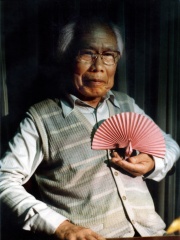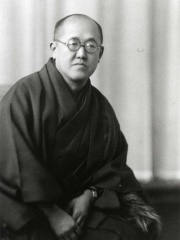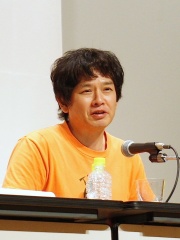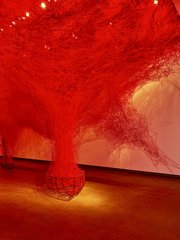







The Most Famous
ARTISTS from Japan
This page contains a list of the greatest Japanese Artists. The pantheon dataset contains 125 Artists, 9 of which were born in Japan. This makes Japan the birth place of the 4th most number of Artists behind Germany, and United Kingdom.
Top 9
The following people are considered by Pantheon to be the most legendary Japanese Artists of all time. This list of famous Japanese Artists is sorted by HPI (Historical Popularity Index), a metric that aggregates information on a biography's online popularity.

1. Hokusai (1760 - 1849)
With an HPI of 84.61, Hokusai is the most famous Japanese Artist. His biography has been translated into 155 different languages on wikipedia.
Katsushika Hokusai (葛飾 北斎; c. 31 October 1760 – 10 May 1849), known mononymously as Hokusai, was a Japanese ukiyo-e artist of the Edo period, active as a painter and printmaker. His woodblock print series Thirty-Six Views of Mount Fuji includes the iconic print The Great Wave off Kanagawa. Hokusai was instrumental in developing ukiyo-e from a style of portraiture largely focused on courtesans and actors into a much broader style of art that focused on landscapes, plants, and animals. His works had a significant influence on Vincent van Gogh and Claude Monet during the wave of Japonisme that spread across Europe in the late 19th century. Hokusai created the monumental Thirty-Six Views of Mount Fuji as a response to a domestic travel boom in Japan and as part of a personal interest in Mount Fuji. It was this series, specifically, The Great Wave off Kanagawa and Fine Wind, Clear Morning, that secured his fame both in Japan and overseas. Hokusai was best known for his woodblock ukiyo-e prints, but he worked in a variety of mediums including painting and book illustration. Starting as a young child, he continued working and improving his style until his death, aged 88. In a long and successful career, Hokusai produced over 30,000 paintings, sketches, woodblock prints, and images for picture books. Innovative in his compositions and exceptional in his drawing technique, Hokusai is considered one of the greatest masters in the history of art.

2. Yoko Ono (b. 1933)
With an HPI of 77.77, Yoko Ono is the 2nd most famous Japanese Artist. Her biography has been translated into 79 different languages.
Yoko Ono (Japanese: 小野 洋子, romanized: Ono Yōko, usually spelled in katakana as オノ・ヨーコ; born February 18, 1933) is a Japanese artist, musician, activist, and filmmaker. Her work also encompasses performance art and filmmaking. Ono grew up in Tokyo and moved to New York City in 1952 to join her family. She became involved with New York City's downtown artists scene in the early 1960s, which included the Fluxus group, and became widely known outside the fine art world in 1969 when she married English musician John Lennon of the Beatles, with whom she would subsequently record as a duo in the Plastic Ono Band. The couple used their honeymoon as a stage for public protests against the Vietnam War with what they called a bed-in. She and Lennon remained married until he was murdered in front of the couple's apartment building, The Dakota, on December 8, 1980. Together, they had one son, Sean, who later also became a musician. Ono began a career in popular music in 1969, forming the Plastic Ono Band with Lennon and producing a number of avant-garde music albums in the 1970s. She achieved commercial and critical success in 1980 with the chart-topping album Double Fantasy, a collaboration with Lennon that was released three weeks before his murder, winning the Grammy Award for Album of the Year. To date, she has had twelve number one singles on the US Dance charts, and in 2016 was named the 11th most successful dance club artist of all time by Billboard magazine. Many musicians have paid tribute to Ono as an artist in her own right and as a muse and icon, including Elvis Costello who recorded his version of "Walking on Thin Ice" with the Attractions for the Every Man Has a Woman tribute album to Yoko Ono, the B-52's, Sonic Youth and Meredith Monk. As Lennon's widow, Ono works to preserve his legacy. She funded the Strawberry Fields memorial in Manhattan's Central Park, the Imagine Peace Tower in Iceland, and the John Lennon Museum in Saitama, Japan (which closed in 2010). She has made significant philanthropic contributions to the arts, peace and disaster relief in Japan and the Philippines, and other such causes. In 2002, she inaugurated a biennial $50,000 LennonOno Grant for Peace. In 2012, she received the Dr. Rainer Hildebrandt Human Rights Award and co-founded the group Artists Against Fracking.

3. Hiroshige (1797 - 1858)
With an HPI of 74.66, Hiroshige is the 3rd most famous Japanese Artist. His biography has been translated into 66 different languages.
Utagawa Hiroshige (歌川 広重) or Andō Hiroshige (安藤 広重), born Andō Tokutarō (安藤 徳太郎; 1797 – 12 October 1858), was a Japanese ukiyo-e artist, considered the last great master of that tradition. Hiroshige is best known for his horizontal-format landscape series The Fifty-three Stations of the Tōkaidō and for his vertical-format landscape series One Hundred Famous Views of Edo. The subjects of his work were atypical of the ukiyo-e genre, whose typical focus was on beautiful women, popular actors, and other scenes of the urban pleasure districts of Japan's Edo period (1603–1868). The popular series Thirty-six Views of Mount Fuji by Hokusai was a strong influence on Hiroshige's choice of subject, though Hiroshige's approach was more poetic and ambient than Hokusai's bolder, more formal prints. Subtle use of color was essential in Hiroshige's prints, often printed with multiple impressions in the same area and with extensive use of bokashi (color gradation), both of which were rather labor-intensive techniques. For scholars and collectors, Hiroshige's death marked the beginning of a rapid decline in the ukiyo-e genre, especially in the face of the westernization that followed the Meiji Restoration of 1868. Hiroshige's work came to have a marked influence on western European painting towards the close of the 19th century as a part of the trend in Japonism. Western European artists, such as Manet and Monet, collected and closely studied Hiroshige's compositions: Vincent van Gogh, for instance, painted copies of some Hiroshige prints.

4. Akira Yoshizawa (1911 - 2005)
With an HPI of 68.65, Akira Yoshizawa is the 4th most famous Japanese Artist. His biography has been translated into 40 different languages.
Akira Yoshizawa (吉澤 章, Yoshizawa Akira; 14 March 1911 – 14 March 2005) was a Japanese origamist, considered to be the grandmaster of origami. He is credited with raising origami from a craft to a living art. According to his own estimation made in 1989, he created more than 50,000 models, of which only a few hundred designs were presented as diagrams in his 18 books. Yoshizawa acted as an international cultural ambassador for Japan throughout his career. In 1983, Emperor Hirohito awarded him the Order of the Rising Sun, 5th class, one of the highest honors bestowed in Japan.

5. Yoshitaka Amano (b. 1952)
With an HPI of 63.13, Yoshitaka Amano is the 5th most famous Japanese Artist. His biography has been translated into 27 different languages.
Yoshitaka Amano (天野 喜孝, Amano Yoshitaka; born March 26, 1952) is a Japanese visual artist, character designer, illustrator, a scenic designer for theatre and film, and a costume designer. He began his career in 1967 at Tatsunoko Production working on anime such as Speed Racer and later became the creator of iconic and influential characters from anime such as Gatchaman, Tekkaman, Honeybee Hutch, and Casshern. In 1982 he went independent and became a freelance artist, finding success as an illustrator for numerous authors, and worked on best-selling novel series, such as The Guin Saga and Vampire Hunter D. He is also known for his commissioned illustrations for the popular video game franchise Final Fantasy. Since the 1990s Amano has been creating and exhibiting paintings featuring his iconic retro pop icons in galleries around the world, primarily painting on aluminium box panels with acrylic and automotive paint. He is a five-time winner of the Seiun Award, and also won the 1999 Bram Stoker Award for his collaboration with Neil Gaiman, Sandman: The Dream Hunters. Amano's influences include early Western comic books, Orientalism, art nouveau, and Japanese woodblock prints. In early 2010, he established Studio Devaloka, a film production company.

6. Hasui Kawase (1883 - 1957)
With an HPI of 61.43, Hasui Kawase is the 6th most famous Japanese Artist. His biography has been translated into 17 different languages.
Hasui Kawase (川瀬 巴水, Kawase Hasui; May 18, 1883 – November 7, 1957) was a Japanese artist who was one of 20th century Japan's most important and prolific printmakers. He was a prominent designer of the shin-hanga ("new prints") movement, whose artists depicted traditional subjects with a style influenced by yōga (Western-style painting). Like many earlier ukiyo-e prints, Hasui's works were commonly landscapes, but displayed atmospheric effects and natural lighting. Hasui designed almost one thousand woodblock prints over a career that spanned nearly forty years. Towards the end of his life the government recognized him as a Living National Treasure for his contribution to Japanese culture.

7. Yoshitomo Nara (b. 1959)
With an HPI of 59.90, Yoshitomo Nara is the 7th most famous Japanese Artist. His biography has been translated into 19 different languages.
Yoshitomo Nara (奈良 美智, Nara Yoshitomo; born 5 December 1959 in Hirosaki, Aomori Prefecture, Japan) is a Japanese artist. He lives and works in Nasushiobara, Tochigi Prefecture, though his artwork has been exhibited worldwide. Nara has had nearly 40 solo exhibitions since 1984. His art work has been housed at the MoMA and the Los Angeles County Museum of Art (LACMA). His most well-known and repeated subjects are "big-headed girls" with piercing eyes, who one Nara scholar describes as having "childlike expressions [that] resonate with adult emotions, [their] embodiment of kawaii (cuteness) carries a dark humor, and any explicit cultural references are intertwined with personal memories."

8. Chiharu Shiota (b. 1972)
With an HPI of 53.24, Chiharu Shiota is the 8th most famous Japanese Artist. Her biography has been translated into 15 different languages.
Chiharu Shiota (塩田 千春, Shiota Chiharu) (born 1972) is a Japanese performance and installation artist and belongs to a generation of artists who have gained international attention in the twenty-first century for body-related art. Shiota has lived and worked in Berlin, Germany since 1996. Educated in Japan, Australia, and Germany, Shiota interweaves materiality and the psychic perception of the space to explore ideas around the body and flesh, personal narratives that engage with memory, territory, and alienation. Her signature installations, which consist of dazzling, intricate networks of threads stretching across gallery rooms, made the artist rise to fame in the 2000s. Shiota has exhibited worldwide. She made her debut in Japan at the Yokohama Triennale in 2001 with Memory of Skin and represented Japan in the 56th Venice Biennale in 2015.

9. Tatsuki Fujimoto (b. 1993)
With an HPI of 48.43, Tatsuki Fujimoto is the 9th most famous Japanese Artist. His biography has been translated into 19 different languages.
Tatsuki Fujimoto (Japanese: 藤本 タツキ, Hepburn: Fujimoto Tatsuki; born October 10, 1992, or 1993) is a Japanese manga artist, known for his works Fire Punch and Chainsaw Man.
People
Pantheon has 9 people classified as Japanese artists born between 1760 and 1993. Of these 9, 5 (55.56%) of them are still alive today. The most famous living Japanese artists include Yoko Ono, Yoshitaka Amano, and Yoshitomo Nara. The most famous deceased Japanese artists include Hokusai, Hiroshige, and Akira Yoshizawa. As of April 2024, 1 new Japanese artists have been added to Pantheon including Chiharu Shiota.
Living Japanese Artists
Go to all RankingsYoko Ono
1933 - Present
HPI: 77.77
Yoshitaka Amano
1952 - Present
HPI: 63.13
Yoshitomo Nara
1959 - Present
HPI: 59.90
Chiharu Shiota
1972 - Present
HPI: 53.24
Tatsuki Fujimoto
1993 - Present
HPI: 48.43
Deceased Japanese Artists
Go to all RankingsHokusai
1760 - 1849
HPI: 84.61
Hiroshige
1797 - 1858
HPI: 74.66
Akira Yoshizawa
1911 - 2005
HPI: 68.65
Hasui Kawase
1883 - 1957
HPI: 61.43
Newly Added Japanese Artists (2025)
Go to all RankingsOverlapping Lives
Which Artists were alive at the same time? This visualization shows the lifespans of the 4 most globally memorable Artists since 1700.

